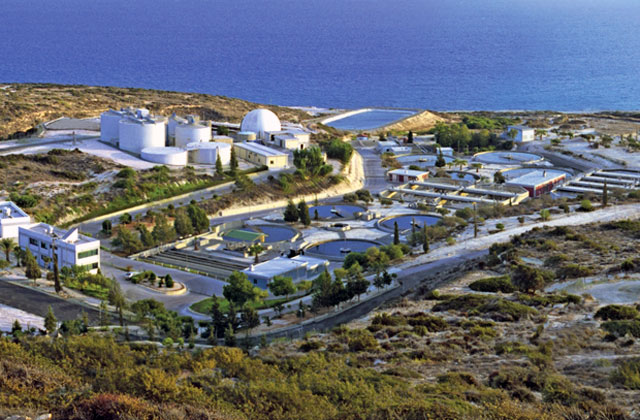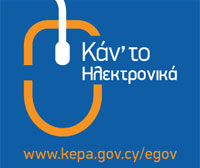Sewage Treatment Plants
1) Biological Sewage Treatment and Recycled Water Production Plant at Moni
The Biological Sewage Treatment and Recycled Water Production Plant at Moni began operations in 1995. It can handle up to 40,000m³ of wastewater per day and has the capacity to treat an organic load of around 16,000kg per day. The Plant produces treated water of excellent quality. Tertiary treated water is suitable for use in agriculture and industry and it is provided to the Water Development Department, which is responsible for its distribution.
The sewerage system contributes to saving water for use in agriculture since the water, which is disinfected at the end of the tertiary treatment stage, is suitable for agricultural and other uses. Through the re-use of the treated water, we conserve water in the reservoirs and aquifers.
Today, the Plant produces around 10 million m³ of treated water per year. This is expected to increase as new areas are connected.
Using Renewable Energy Sources
BIOGAS
In addition to the re-use of water and biosludge, biogas is also produced for use in generating electricity and heat, thereby contributing to energy-saving.
Since 1 September 2008, the Board has operated two 311kV biogas generators for electricity and heating.
Biogas, resulting from the anaerobic digestion of biosludge, is collected in a 2,000m³ capacity gas holder. Τhe biogas produced in the sludge digesters is used as a renewable energy source, i.e. as ‘green’, environmentally friendly energy, to operate electricity generators. The heat created by the generators is used for heating the digesters, while the generated electricity, which today amounts to some 5,000kWh per day, is used to operate the Biological Sewage Treatment and Recycled Water Production Plant at Moni, reducing by 35%-40% the daily consumption of electricity provided by the Electricity Authority of Cyprus that is required to operate the Plant.
At the same time, the generated thermal energy, which today amounts to around 4,000kWh per day, is used to heat sludge as an alternative source heating. Due to the controlled production of biogas, the level of pollutant emissions is extremely low.
In this way, a significant amount of energy is saved and, at the same time, any additional environmental impact is reduced. On the basis of the Plant’s current operating levels, the amount of electricity produced by the biogas generators is approximately 4,500kWh per day, while with the expansion of the networks, this is expected to increase to 5,000kWh daily.
The Board secured the funding of the initial capital expenditure from the Ministry of Energy, Commerce & Industry’s Energy Department’s funding programme the use of RES. The cost of the investment was around €2 million and the funding €320,000.
BIOSLUDGE
Treated sludge (biosludge) produced through sewage treatment is suitable for use in agriculture, forestry, gardening, landscaping and mining (improving the soil to reintroduce vegetation and revitalize greenery).

2) West Limassol Biological Sewage Treatment and Recycled Water Production Plant
The Plant stands on agricultural land within the administrative boundaries of the Municipality of Kato Polemidia inside the Sovereign Base Areas, away from populated areas and adjacent to the Rainwater Retention Lake. It is located some 500 metres from the 1st Limassol Industrial Zone and 1,200 metres from the nearest residential area in the Municipality of Kato Polemidia.
The contract for its construction was signed on 30 November 2018 with the Kruger A/S – Cybarco Limited JV consortium. Work began in January 2019 and construction work was completed in September 2022. The Project was included in the Programming Period 2014-2020 for European Projects co-financed by the EU Cohesion Fund. The approximately €30 million Project was co-funded by the Government and the SBLA.
On 7 March 2020, the foundation stone of the West Limassol Biological Sewage Treatment and Recycled Water Production Plant was laid by the then President, Nicos Anastasiades.
The Plant, with a capacity of 13,000 cubic metres per day, serves Polemidia, Zakaki, Agios Spyridon and other areas of West Limassol. It also serves Limassol General Hospital, Limassol New Port, the 1st Limassol Industrial Zone and two major commercial developments: the City of Dreams Mediterranean integrated resort and the My Mall shopping centre. The Plant will eventually be capable of serving 65,000 residents.
The Plant is one of the most important infrastructure projects undertaken in the city and district of Limassol. It involves state-of-the-art technology and is of major environmental significance. Its design took into consideration the need to reduce noise and odour to a minimum or even zero and was based on the membrane technology used in tertiary treatment.
On 4 November 2023, the SBLA’s West Limassol Biological Sewage Treatment and Recycled Water Production Plant was officially inaugurated by President Nikos Christodoulides.
BUILDINGS
STAGES OF TREATMENT
Wastewater inflow (K.01):
Wastewater flows by gravity into the Plant from the highest areas and is pumped from the lower areas via the SBLA pumping station No. 6 which is located in the Lady’s Mile area.
Pre-treatment (K.02):
On arrival at the Plant, the wastewater undergoes pre-treatment, passing through two 6mm diameter filters and three 1.5mm diameter filters. Everything collected is compressed and placed in closed crates and transported to authorised areas. The wastewater is then transferred by gravity into two adjacent tanks for the removal of fat, grease and grit. These tanks are enclosed to avoid the leaking of any odours into the environment. The collected grease and fat are channelled into the digester (B.12).
Next, sand, grit and other heavier-than-water solids that settle are pumped into a sand-collecting channel, separated from the liquid area and transported in a closed lorry to an authorized treatment unit.
Lagooning (K.03):
The wastewater is passed by gravity from the pre-treatment stage to two adjacent tanks, enclosed to avoid the leaking of any odours. At this stage, the organic load is reduced by 20%-40% and that of suspended solids by 40%-60%.
Biological Treatment (K.05):
The wastewater then overflows into two circular aeration basins through the separation drain, where two lines of sludge recycling also terminate. During the biological treament process, wastewater and micro-organisms are mixed together and remain in the two tanks with a controlled air and agitation rate. The degradation of the organic load is achieved through the correct conditions of temperature, oxygen and contact time. The tanks operate in aerobic cycles (with the presence of oxygen – nitrification) and anoxic cycles (absence of oxygen – denitrification).
Membrane Bioreactor Treatment (K.07):
From the aeration basins, the mixture of water and biosludge is passed by gravity through the separation drain into tanks where it is filtered by passing through the membrane bioreactor. There are three filtration lines via membranes within an enclosed system to prevent the leaking of any odours into the environment. These lines are used as a final filter in the production of tertiary treated water.
UV Disinfection (K.09):
The tertiary treated water from the membrane bioreactor is disinfected through the use of ultraviolet radiation, so as to fully inactivate any traces of micro-organisms.
Pumping Station for Irrigation and Emergencies (K.23):
The tertiary treated water, having been disinfected by ultraviolet radiation, is channelled into the reservoir of the Water Development Department (WDD), which undertakes its distribution for the irrigation of agricultural areas and the enrichment of the aquifer.
Sludge Treatment (K. 10, 11, 12):
The resultant sludge is thickened and treated by anaerobic digestion and dehydration. Dehydrated sludge, with a minimum moisture content of 25% after treatment, is placed in a 70m3 storage space and loaded onto a lorry, which transports it to an authorized unit.
Biogas (K.13, 15):
Biogas resulting from the anaerobic digestion of biosludge is fed into units that generate electricity and heat. The electricity is used to meet the Plant’s own needs while the heat is used to warm the sludge in the digester.
Chemicals Building (K.16):
This building stores ferric chloride, which is used to reduce phosphorus levels when needed.
Deodourisation System (K.17):
Deodourisation systems have been installed at every stage of the treatment process where there is a possibility of odours leaking, resulting in the minimum emission into the environment.
Renewable Energy Sources:
The Plant is equipped with 200kW photovoltaic systems, with a provision for this capacity to be increased by a further 100kW. Furthermore, the biogas produced is used to generate electricity and heat as mentioned above.
Electrical Equipment Building (K.20):
This building stores electronic panels, the backup generator and other electrical equipment.
Administration Building (K. 19)
The Administration Building contains the personnel offices and a control room from which the entire Plant is fully monitored. The Plant operates an advanced SCADA system, noise monitoring systems, an ultramodern laboratory and other cutting-edge technology.
The West Limassol Biological Sewage Treatment and Recycled Water Production Plant is one of the most important infrastructure projects undertaken in our city. It is undoubtedly a project that improves our quality of life, contributes to economic activity and promotes environmental protection.






